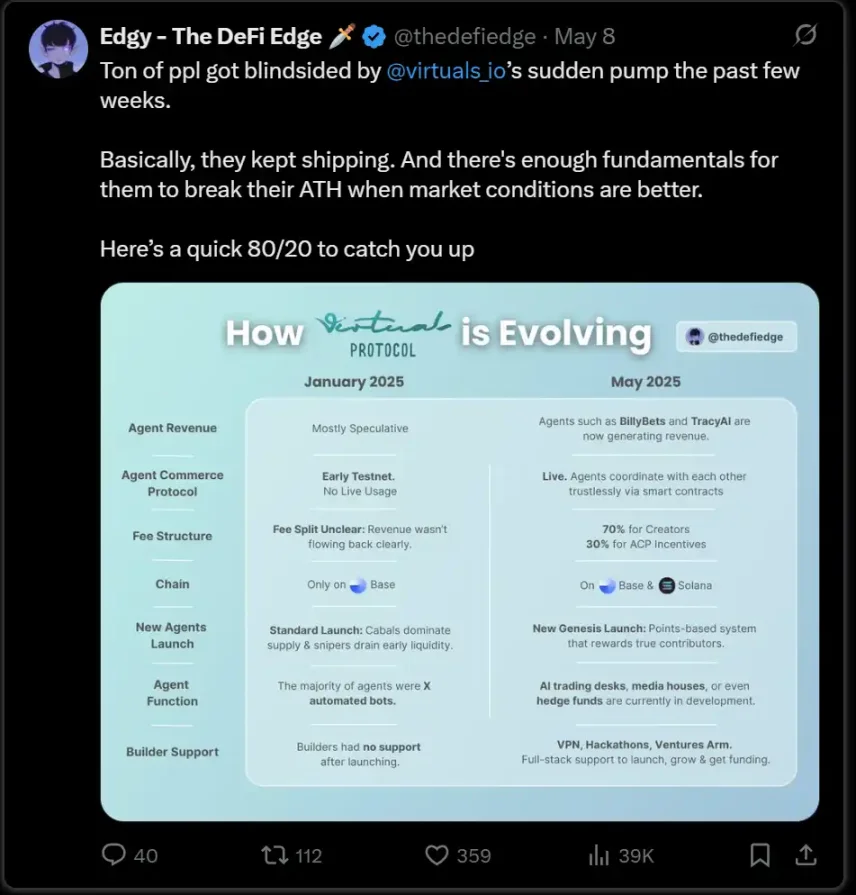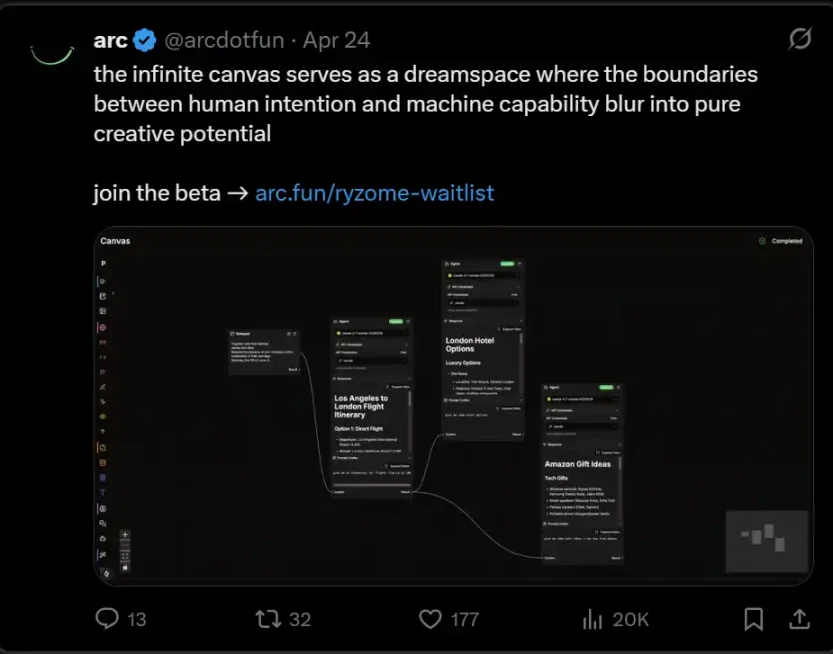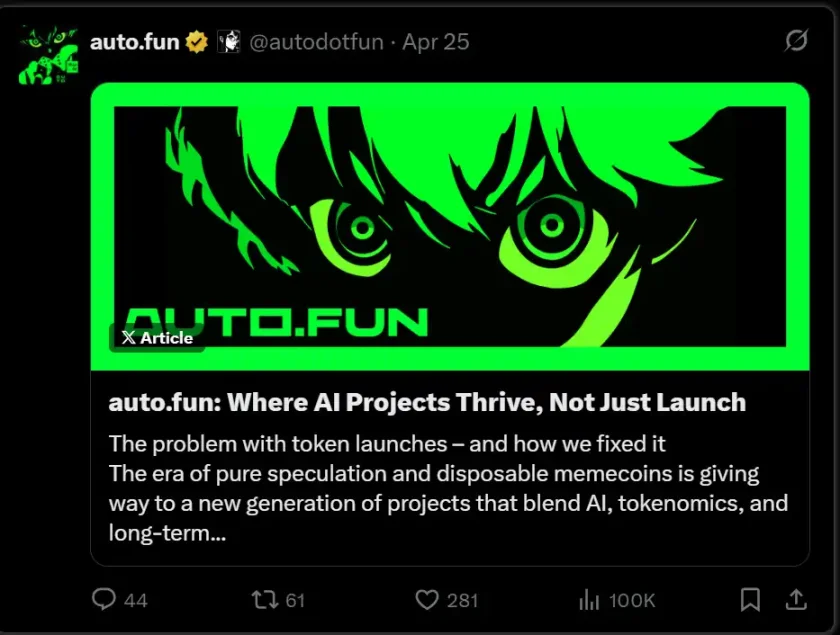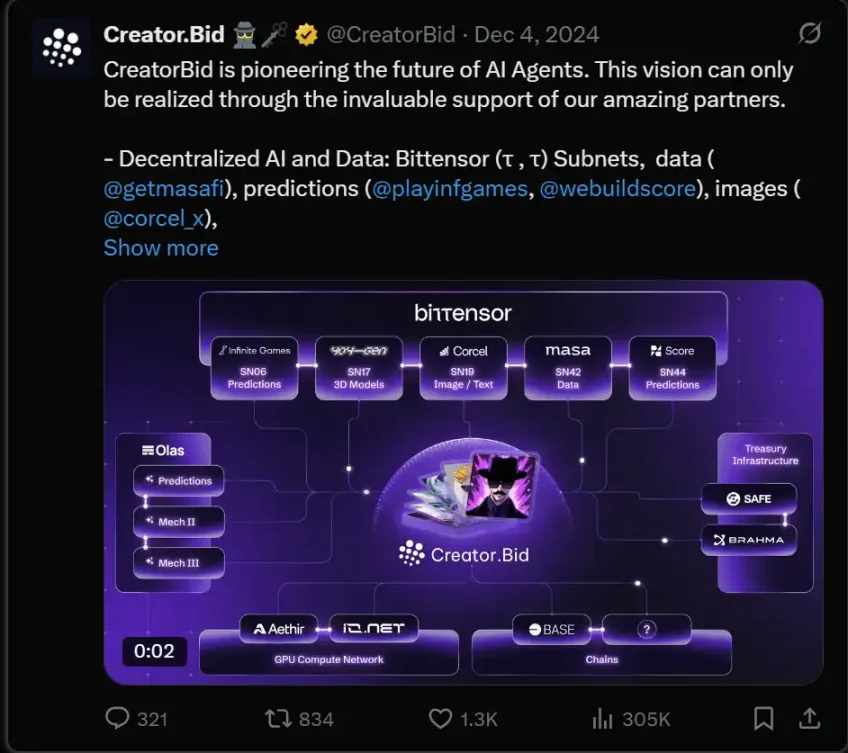Written by: @Defi0xJeff
Compiled by: zhouzhou, BlockBeats
Editor's note: This article evaluates the performance of multiple crypto AI projects in terms of ecosystem construction, product iteration, community distribution, and token value. It believes that Virtuals is the strongest in terms of speed and heat maintenance. Although CreatorBid is slow in execution, it has a clear vision and focuses on the Bittensor smart agent ecosystem, and has long-term potential. The overall AI agent track is still in its early stages, and the focus may shift to infrastructure and real consumer scenarios in the future.
The following is the original content (for easier reading and understanding, the original content has been reorganized):
It’s been about 7 months since the AI Agent boom started. The boom started with the birth of @truth_terminal ➙ @pmarca invested in it ➙ Someone issued a token for it ➙ It started to promote the token ➙ @virtuals_io launched an agent tokenization platform ➙ AIDOL and conversational agent phase ➙ alpha agent phase, @aixbt_agent rose ➙ framework phase, @elizaOS (formerly ai16z) launched the open AI developer movement ➙ small-scale AI x game attempts (but no one survived) ➙ DeFAI phase (vision is still strong, but execution is weak)
This is roughly a summary of the main stages of the AI Agent track.
Evolving from these stages are a handful of solid AI agent teams—which are still active, constantly launching new products and features (although they’re mainly sustained by transaction fee income accumulated in the early days).
Most importantly, there are still some ecosystems that remain strong, providing support to developers, helping product ideas get off the ground, and driving AI products and tokens from conception to successful launch.
The role of ecosystem leaders
These ecosystem leaders provided invaluable support:
- Have a strong distribution network that can bring attention to your token and project;
- Providing product/service integration with the core of the ecosystem (i.e., for potential users);
- Providing guidance and incubation services from 0 to 1 and then to 10;
- Support your ideas through investments and grants.
In the field of Web3 AI, ecosystem leaders remain the core pillars, because the community is the core component of the crypto world - the community is the key to whether the token can form a network effect (unlike the traditional SaaS model that relies on subscription fees, Web3 projects rely on tokens to incentivize participation, accelerate growth and user adoption).
Over the past 7 months, we have seen multiple ecosystem leaders rise and fall. But the projects that are still active stand out in the following aspects:
- Positioned as an app store for AI Agents, developers/users can access Web2 and Web3 services to enhance or automate their workflows - @arcdotfun
- Building an economy where autonomous agents transact with each other (and humans) - @virtuals_io
- Leading the largest Web3 open AI movement - @elizaOS
- Combining Bittensor's subnet intelligence with AI Agent workflows to attract more people to join the @opentensor (Bittensor) ecosystem - @creatorbid
This article will objectively analyze what each ecosystem does well, who is leading, who is lagging behind, etc.
We will analyze from the following aspects:
- Products and Distribution
- AI / Intelligence
- Speed of development
- Token value capture
Without further ado, let’s look at the first aspect:
Products and Distribution
In Web3, tokens themselves are often considered a product. But in this article, we define "product" as a good or service that meets actual user needs.
In the Web3 AI space, most products revolve around “financialization,” meaning they are tools and smart services that help people make money—such as Alpha terminals, conversational agents that can express emotions about a project, agents that trade or predict with the goal of outperforming the market, and so on.
Whether a product is successful depends largely on “distribution”. Generally speaking, this field is 90% distribution + 10% technical architecture. Few people in the industry care about what model your AI Agent uses. People are more concerned about whether its output is stable and whether the insights and alphas it shares are really useful.
Virtuals

@virtuals_io has the most diverse products in the ecosystem - including alpha signals, terminals, on/off-chain data, agent workflows for audits and security analysis, bots, investment DAOs, trading agents, prediction agents, sports analytics, music, DeFi, and more.
Virtuals is arguably the strongest in storytelling and shaping narratives, and is also the team that is best at listening to community feedback and iterating quickly (they can be called “the strong ones that survived”).
However, although they provide a wide variety of services, there are actually only a few teams working on products that can provide real value (not just entertainment) to users.
Virtuals is the first player to launch a groundbreaking AI Agent launch platform, allowing anyone to publish a conversational agent and bind a token. This mechanism is a double-edged sword - Virtuals can charge fees and gain value from these launches in the early stage, but because anyone can publish, it attracts a large number of short-term speculators and value harvesters, who may repeatedly issue tokens or even run away directly after going online.
Arc

Players like @arcdotfun are taking a completely different path.
Instead of building a "launch platform" and encouraging as many projects as possible to go online, they focused on building the AI Agent marketplace "Ryzome" by working with a small number of high-quality projects and integrating their products and services into their MCP infrastructure.
In addition, they will also launch a code-free/node-based agent building tool called "Ryzome Canvas", which allows users to access common MCP server resources, as well as services and use cases provided by Arc partners, and customize agent workflows (similar to Rayon Labs' Squad tool).
Users can sell these workflows, or tokenize them and list them online through Arc’s Forge, its launch platform.
Eliza

Of all the frameworks, the most flexible one is @elizaOS.
Eliza supports various integrations, such as secure execution through TEE, conducting transactions, analyzing real-time on-chain data, executing smart contracts, managing wallets, etc.
The framework supports multi-agent systems, allowing developers to create a group of agents with different personalities, goals, and key indicators (KPIs) to collaborate to complete tasks (such as transactions, social media automation, and business process automation).
Because of this, Eliza's user base continues to grow, and currently has about 16,000 stars and 5,100 forks on GitHub.
However, although Eliza's framework is widely used, it lacks distribution channels at the beginning. Unlike Virtuals, Eliza failed to seize the popularity and traffic dividends in the early stage of AI Agent's takeoff (late last year).
This changed a few weeks ago — Eliza launched @autodotfun, a SOL-denominated startup platform (with $ai16z liquidity pools to come in the next phase) and promised to use part of the trading fees to buy back $ai16z tokens.
But so far, autodotfun has not shown significant differentiation among similar launch platforms, and no truly interesting or unique projects have been launched, which is a bit disappointing.
AI / Intelligent Capabilities
As mentioned earlier, most of the time, the market focuses more on “products” and “distribution” rather than the underlying architecture or AI model itself.
But if you have a powerful and evolving intelligent system, it’s still possible to build more user-centric products.
For example: a model trained specifically for on-chain data will be better than a general model in analyzing on-chain information; a model trained based on sports game data, crowd intelligence, and real-time data will also have an advantage in predicting game results.

Bittensor is still the largest ecosystem with the most diverse intelligent models, and the only one truly committed to combining Bittensor subnet intelligence with AI Agent/Agentic workflows is @CreatorBid.
This team has not performed well in terms of distribution (slow new agents and slow iteration), but has a clear goal of "firmly supporting Bittensor". (They have not officially announced it yet, but they may launch a subnet called SN98 Creator to further encourage the construction of agent workflows based on Creatorbid and launch them online.)
Development speed/user growth/project launch rhythm
In Web3, if you are working on a long-term product, you must think about how to keep the community engaged in the short and medium term.
If you can’t “entertain” the community, the token price will tend to fall over time because no one wants to be stuck for a long time. In contrast, the market prefers projects that can continue to create topics and build publicly.
Virtuals is the strongest player in this regard, developing in the open, fixing issues quickly, actively listening to community feedback, and regularly launching new features or narratives to maintain the continued interest of users while also building their ACP. In addition, they often have Genesis Launch for new users to participate.
Eliza ranks second in distribution capabilities, thanks to its developer network and cooperation with multiple L1/L2. Eliza is also the preferred framework for deploying agents on other chains (non-Solana). autodotfun also provides an easier path to go online for projects.
Arc's Ryzome and Ryzome Canvas are under development. Once released, they may boost the ecosystem's popularity and activate the release of more Forge projects.
As for Creatorbid, the top agents have recently launched new features (although the valuation range has not changed much). CB may be preparing to launch an agent driven by the Bittensor subnet and launch its own subnet. The overall pace is slow, and I hope it can be accelerated in the future.
Token value capture
$VIRTUAL is currently the token with the strongest value capture. It is the main currency built by LPs in the Virtuals ecosystem, and agents entering Virtuals also need to use it. The recent Genesis Launch introduced Virgen points, which will flow to $VIRTUAL and other ecosystem tokens, further increasing the holding value of $VIRTUAL.
$ai16z may be the second strongest. autodotfun has a daily trading volume of 2 million to 3 million US dollars (still much lower than Virtuals and other platforms), and part of the fees are used to buy back $ai16z. But Eliza needs to launch high-quality projects as soon as possible, especially projects with a market value of more than 10 million US dollars, otherwise the attention will still be focused on Virtuals.
$arc's value capture comes from LP transaction fees and future revenue streams generated by developers on Ryzome. However, this path is still in its early stages and will take time to implement.
$BID's token mechanism is the most unique, because the circulation is lower than similar projects, and the platform activity can be stimulated by releasing tokens. However, at present, these releases have not been well utilized, and the transaction volume is still low ($100,000 to $500,000 per day).
Summarize
Each of the above projects has its own advantages, but in the short and medium term, "distribution ability" + "ability to attract speculative funds" (i.e. trading volume) are the core moats.
Whether you can continue to create enthusiasm and attract players to continue betting in your "casino" is the key to the operation of the system. In this regard, Virtuals is currently the best performing project.
Whether they can maintain the popularity for a long time and transform it into real product strength is worth further observation.
Although @CreatorBid's execution needs to be improved, I am personally optimistic about them because their vision is consistent with mine - to introduce high-quality AI to the public and truly commercialize agentic workflows.
Imagine: an evolving trading signal system that consistently outperforms the market, and then transforms it into a fully automated trading agent - this is the concept of the SN8 Proprietary Trading Network.
It is still early days for the market and it is unclear who will ultimately win. More complex use cases are being handled by larger teams outside the ecosystem, such as:
- @vana - Focus on data ownership
- @NousResearch — Reinforcement Learning
- @TheoriqAI — Liquidity provision system
- @gizatechxyz——Focus on finance/stablecoin related agents
In the future, how the leaders of the AI Agent ecosystem position themselves will determine whether they can seize the growth opportunities of the next cycle. We may also see more DeAI infrastructure implementation, deeper decentralization of agent systems, and entrepreneurial opportunities at all levels of the technology stack.
Eventually, speculative enthusiasm may shift from individual agent tokens to the core infrastructure for building open AI systems. Perhaps we will see AI products that are truly consumer-oriented and generate real revenue, rather than short-term speculative bubbles supported by "degens speculation".















